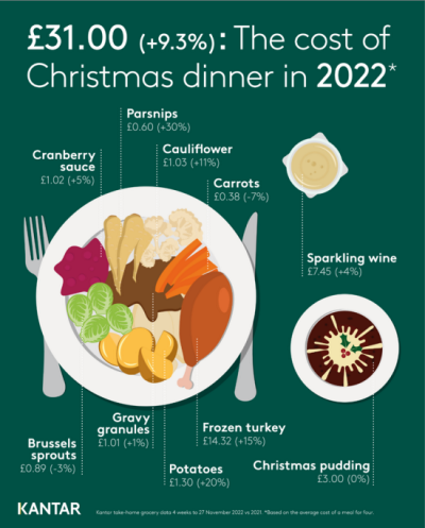The rate of grocery price rises has fallen for the first time in nearly two years, according to latest figures from Kantar, with four-week inflation edging down 0.1 percentage points to 14.6%. However, facing a costly Christmas, the consumer exodus to the discounters continued with both Aldi and Lidl recording sales growth of close to 25%.
Whilst noting that there were signs that the pace of price rises in the grocery sector is easing, Fraser McKevitt, head of retail and consumer insight at Kantar, stressed that inflation still has a long way to come down. Based on the current rate, shoppers will have to spend an extra £60 in December to buy the same items as last year. “The cost of a traditional Christmas dinner for four has hit £31 (+9.3%) in 2022, an example of just how much rising prices are impacting people at the tills and in their daily lives,” he said.

Meanwhile, take-home grocery sales increased by 5.9% year-on-year over the 12 weeks to 27 November 2022, the fastest level of growth since March 2021. The combination of inflation and festive spending means that the coming month is on course to be the biggest ever for take-home grocery sales. McKevitt commented: “December looks set to be a record-breaking month with sales going above the £12bn mark for the first time. We’re expecting Friday 23 December to be the busiest day for pre-Christmas shopping.”
Kantar noted that consumers are leaving their seasonal purchases later this year as they try to manage budgets in the run-up to Christmas Day. Data shows that sales of mince pies, Christmas puddings and Christmas confectionery are worth 2% more than last year, but this is largely due to higher prices. “If we look at the amount of people buying these items and the overall number of purchases made, then sales are actually down on 2021,” said McKevitt.
“We’re seeing yet more evidence of the coping strategies shoppers are adopting to mitigate rising costs, and in particular own-label sales are growing at pace, now up 11.7% year on year. The cheapest value own-label lines have soared by 46.3%, but people still want to find room for treats at this time of year and this is driving growth at the other end of the spectrum too. Premium own label sales are up by 6.1% to £461m in November.”
Kantar’s data confirms that the strong growth of the discounters continued over the latest 12-week period, boosted by new store openings and cash-strapped shoppers seeking to reduce their grocery spending. Lidl’s year-on-year sales jumped 22.0%, pushing its market share to a record 7.4%. Meanwhile, an additional 1.5 million households shopped with Aldi compared to 2021, driving its sales up 24.4% to claim 9.3% of the market.
Asda continued its recovery, with sales growth ahead of the sector, up by 6.1%, keeping its share steady at 14.0%. Tesco’s market share fell to 27.2% as its sales rose by only 3.9%. Sainsbury’s sales increased by 4.3%, but its share slipped to 15.2%.
Morrisons and Waitrose continued their poor run, with sales falling 4.7% and 1.8%, respectively.

Meanwhile, despite England’s success in the World Cup, Kantar noted that there had yet to be a big effect on food and drink sales. Take-home beer sales nudged up slightly in the last four weeks, covering the first week of the tournament, by 5% to £230m, but mostly due to increased prices. McKevitt commented: “Many people are taking the chance to enjoy a social pint while watching the games in bars and pubs, whereas last year we were in the middle of a Covid resurgence so consumers were limiting their movements and going out less. We’re likely to be marking the impact of that comparison with higher at-home volumes one year ago. Crisp and snacks have fared better this winter, however, with sales up by 18%.”
NAM Implications:
- ‘four-week inflation edging down 0.1 percentage points to 14.6%’
- Too late for some, not enough for most…
- But enough to boost discounters by 25%.
- Meanwhile, ‘consumers are leaving their seasonal purchases later’.
- Cheapest value own-label lines growing by 46.3% has to be at the expense of brands in many categories.
- The nightmare scenario for the mults has to be the question of how many consumers, having found the discounters and value own-label better than expected…
- …will stick with their new behaviours if things return to normal.



